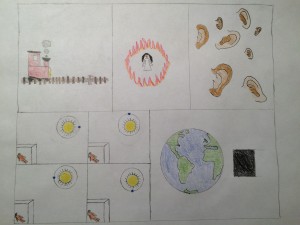Sultana’s Reality

If Sultana’s Dream was meant to be an idyllic, feminist quasi-utopia, then Sultana’s Reality is a representation of the grim truths faced by Rokeya Sakhawat Hossein and her female contemporaries during her lifetime. Based on excerpts from another of her works, The Secluded Ones, I’ve attempted to visually respond to some of the unimaginable horrors women in that time faced, choosing the cartoon as a medium so as to attenuate the atrocities to a level palatable even for younger audiences, as Satrapi did for Persepolis.
In the first panel, based on Report 14 of The Secluded Ones, a typical damsel-in-distress scene is evoked, with a woman tied down to the tracks as a train approaches. While the rope symbolically represents the restriction of women by purdah, the illustration masks the infinitely more gruesome and disturbing true tale told by Rokeya. In the second panel, toned down from Report 8, a women lies surrounded by flames, again serving as a subdued metaphor for the emotionally and physically painful limitations inflicted upon women by purdah. In the following scene, the disembodied ears can be seen as a metaphor for the deaf ears any complaints concerning purdah were likely to fall on during those times, but in actuality it is based off of the Resevoir Dogs-esque proceedings from Report 7.
In the next panel, derived from Report 11, I depict the passage of time by the position of the earth in its orbit around the sun, whilst one of Rokeya granddaughters remains confined to a cell for months on end, all to fulfill certain traditions of marriage. Her orange clothes are meant to give the appearance of being in prison, for, no matter how exceedingly depressing it is to acknowledge, I can see no difference between her condition and that of someone guilty of committing a crime. In the final panel, inspired by Report 25, I juxtapose the Earth with a black, light-tight box that is implied to contain Rokeya and her granddaughters, per purdah, as they attempt to see the world. The absurdity of the situation is amplified by that of the drawing itself, inviting the viewer to wonder how it could’ve escaped the notice of so many others in the past, or perhaps more importantly to encourage reflection on what obvious contradictions are being missed or ignored en masse today.